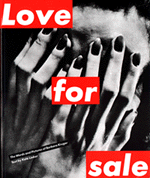Anna-Kate. 2009. Feminist progress: undermined by the Media?. Available at:
http://www.thefword.org.uk/features/2009/01/feminist_progre [Accessed 24th January 2012]
Barnard/Columbia Women's Handbook. 1992. Chapter 3: Body Image and "Eating Disorders". 2005. Available at:
http://feminism.eserver.org/real-and-ideal-body-image.txt [Assessed 24th January 2012]
Berger, J. et al., Ways of Seeing. London. British Broadcasting Corporation and Penguin Books LTD
Butler, C. et al., Mark, L J, ed., 2007. Wack! Art and the Feminist Revolution. MA. MIT Press
Deepwell, Katy. ed., 1995. New Feminist Art Criticism. Manchester. Manchester University Press
Elizabeth A. Slacker Center For Feminist Art. The Dinner Party. Available at:
http://www.brooklynmuseum.org/eascfa/dinner_party/home.php [Accessed 28th January 2012]
Feminist Media. 2011. Taking back the media. Available at:
http://feministmedia.tumblr.com/ [Accessed 24th January 2012]
Fitzpatrick, L. 2010. The New Sexism. Available at:
http://www.time.com/time/nation/article/0,8599,1972425,00.html [Accessed 24th January 2012]
Kim, H. 2010. MoMA. Listening to Marina Abramovic: Art Must Be Beautiful, Artist Must Be Beautiful. Available at:
http://www.moma.org/explore/inside_out/2010/04/06/listening-to-marina-abramovic-art-must-be-beautiful-artist-must-be-beautiful [Accessed 9th March 2012]
Jones, A. ed., 2003. The Feminism And Visual Culture Reader. Oxon. Routledge
Judy Chicago and Donald Woodman. 2012. Judy Chicago, The Dinner Party (1974 - 1979). Available at:
http://www.judychicago.com/gallery.php?name=The+Dinner+Party [Accessed 28th January 2012]
Katie Miller. Katie Miller. 2011. Available at:
http://artistkatiemiller.com/index.htm [Accessed 15th February 2012]
Kinzel, L. 2010. Two Whole Cakes. Madonna, Lady Gaga and Breaking the Male Gaze. Available at:
http://blog.twowholecakes.com/2010/06/madonna-lady-gaga-and-breaking-the-male-gaze-a-close-reading-of-alejandro/ [Accessed 1st March 2012]
Lacey, N. 1998. Image And Representation. Key Concepts In Media Studies. London. Macmillan Press LTD
Lont, M, Cynthia. 1995. Women And Media. Content, Careers, and Criticism. CA. Wadsworth Publishing Company
Marie Claire. A Beautiful Mind. 2012. Available at:
http://www.marieclaire.com/world-reports/inspirational-women/autistic-female-artist [Accessed 15th February 2012]
Meyers, M. ed., 1999. Mediated Women, Representations in Popular Culture. NJ. Hampton Press, Inc
Mulvey, L. 1975. Visual Pleasure and Narrative Cinema. Available at:
https://wiki.brown.edu/confluence/display/MarkTribe/Visual+Pleasure+and+Narrative+Cinema [Accessed 1st March 2012]
National eating Disorder Association. 2005. Statistics: Eating Disoders and their Precursors. Available at:
http://www.sc.edu/healthycarolina/pdf/facstaffstu/eatingdisorders/EatingDisorderStatistics.pdf [Accessed 10th March 2012]
Net Industries. 2012. Periodization of the Arts. Feminism and Periodization. Available at:
http://science.jrank.org/pages/10628/Periodization-Arts-Feminism-Periodization.html [Accessed 29th February 2012]
Viso, O, M. 2004. In depth Ana Medieta. Available at:
http://hirshhorn.si.edu/visit/in_depth.asp?key=33&subkey=57 [Accessed 13th March 2012]
Private website. ©2003–present. The Art of Barbara Kruger. Available at:
http://www.barbarakruger.com/art.shtml [Accessed 26 January 2012]
Rain9959. 2011. Jean Kilbourne. Killing Us Softly 4 (2010) - 1/2. (video online) Available at
http://www.youtube.com/watch?v=1ujySz-_NFQ&feature=player_embedded [Accessed 25th January 2012]
Rockyoumentally. 2009. Marina Abramovic - Art must be beautiful. (video online) Available at:
http://www.youtube.com/watch?v=Z_VxR3TUdoU&feature=player_embedded#! [Accessed 9th March 2012]
Rosen Orosan-Weine Tang Journal of Eating Disorders, Vol.5. 1997. National Centre For Eating Disorders. Body Image. Available at:
http://www.eating-disorders.org.uk/body-image.html [Accessed 24th January 2012]
SchillerJared. 2010. Marina Abramovic interview at the Lisson gallery. (video online) Available at:
http://www.youtube.com/watch?v=i-nAlIcs6yo&feature=player_embedded [Accessed 9th March 2012]
Scopophilia. 2012. Dictionary.com.
The American Heritage® Stedman's Medical Dictionary. Houghton Mifflin Company.
http://dictionary.reference.com/browse/scopophilia [Accessed 2nd March 2012]
sfmoma. 2012. Judy Chicago on feminist art. (video online) Available at:
http://www.youtube.com/watch?v=UA9cp9jqHZE&feature=related [Accessed 30th January 2012]
Sturken, M. and Cartwright, L., Practices of Looking, An Introduction to Visual Culture, Second Edition. Oxford. Oxford University Press
Sushiflower21. 2007. Wack! Art and the Feminist Revolution. (video online) Available at:
http://www.youtube.com/watch?v=Rm2AAl_Rs_Q [Accessed 21st January 2012]
The Lilith Gallery Network. Barbara Kruger, The Art History Archive - Feminist Art. Available at:
http://www.arthistoryarchive.com/arthistory/feminist/Barbara-Kruger.html [Accessed 26th January 2012]
Tpiper. 2007. Beauty Pressure. (video online) Available at:
http://www.youtube.com/watch?v=Ei6JvK0W60I [Accessed 13th March 2012]
Visual Artists and Galleries Association. The Art of Hannah Wilke.
Available at:
http://www.hannahwilke.com/index.html [Accessed 2nd February 2012]
Watkins, S. et al., Appignanesi, R, ed., 1992. Introducing Feminism. UK. Icon Books UK
Whittaker, H. 2008. Glamour models made me sick. Available at:
http://www.thefword.org.uk/features/2008/01/glamour_models [Accessed 24th January 2012]
Wojtczak, H. English Women's History. Women's status in mid 19th century. Available at:
http://www.hastingspress.co.uk/history/19/overview.htm [Accessed 28th February 2012]
xtraonline. 2010. TIFF 2010: ! Women Art Revolution explores the feminist art movement. (video online) Available at:
http://www.youtube.com/watch?v=cBMPPxU9pfM [Accessed 2nd February 2012]













.jpg)

